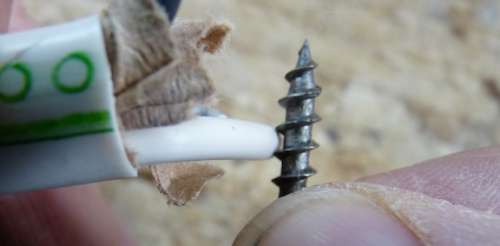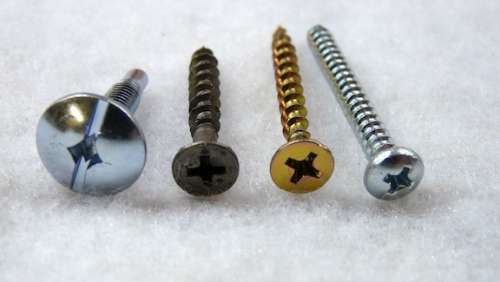Removing Panel Screws
Once it has been determined that the panel’s surface is not energized, the next step is to remove the screws securing the cover or dead front. This can also be dangerous. Screws manufactured for securing dead fronts have shallow-cut, closely spaced threads, which reduces the chance that the threads will cut through the insulation protecting the wires as the screws are withdrawn. However, it’s not uncommon for the original screws to be lost and for improper types of screws to be substituted.
In the two photos above, you can see the difference between the finer threads on the screw from a Square-D panel and the more deeply cut, widely spaced threads of a typical coarse-thread screw. The risk of cutting through the insulation that protects the wire conductors may be greater with the threads along the shaft of the screw than with the point of the screw.
As a screw is withdrawn, it may trap a conductor against the side of the enclosure or the back of the dead front, increasing the chances that the screw threads will cut into the insulation, bringing the energized wire into contact with the grounded metal panel. This can shock any inspector not using an insulated screwdriver, as well as cause an arc flash and explosion, which can send bits of metal flying through the air at high speed. Inspectors not wearing eye protection can suffer serious eye injury or permanent blindness. This type of accident can also result in serious burns.
The photo above shows (from left to right) a proper dead front or panel cover screw, along with three improper but commonly used screws, including a particleboard screw, a gold deck screw, and a machine screw.
We recommend that inspectors not attempt to remove improper screws but, instead, disclaim conditions inside any affected panels and recommend correction by a qualified electrical contractor. Home inspection fees are not lucrative enough for an inspector to justify taking serious risks, and when improper screws have been used to secure the dead front, the odds that something bad will happen are significantly increased.
Shutting Off the Main Disconnect
The common practice among inspectors is to inspect main panels with all branch circuits energized, but they have the option of turning off the power to the main bus using the main disconnect in panels that have an integral main disconnect. This will shut off power to the circuit breakers and the branch-circuit conductors, reducing the chance of an arc flash caused by a screw cutting the conductor insulation, but they should note that the service entrance conductors will still be energized. In panels with a remote disconnect, shutting off the disconnect will shut off power to an entire panel. The same is true for sub-panels fed by a disconnect located in a main panel.
The disadvantage to shutting off the power to the circuit breakers is that any electronic devices in the home that are connected to the affected circuits will suffer power interruption. Computers may lose unsaved information, clocks will need to be reset, etc. With so many different types of electronic devices available, identifying all the potential problems is difficult or impossible.
Inspectors who intend to shut off power to the branch circuits should get permission from the home’s occupant prior to starting the inspection. Even with the occupant’s permission, problems may arise due to the inability of the occupant to anticipate them. Inspectors should develop their own policies and should do so only after developing a solid understanding of the dangers involved. Knowledgeable inspectors should establish policies based on their comfort level with opening panels containing energized components.
Those operating multi-inspector firms may need to view this issue from a different perspective, especially if they are responsible for developing protocols that will be followed by each employee. The electrical inspection skills and comfort levels of employees may vary considerably. In an effort to impress an employer, employees may not always be truthful in describing their skill levels.


